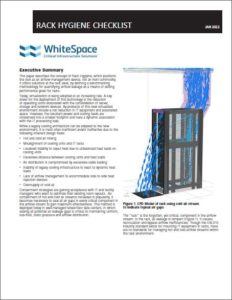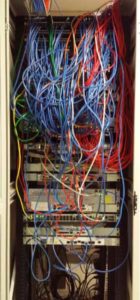Data centre managers are paying close attention to rack-level airflows these days, and with good reason. If cool air cannot enter the rack, flow through the equipment and exit properly, you could run into problems including:
And something else we’ve seen happen… you could end up blowing three hundred grand on an additional CRAC unit that you didn’t need!
Whether you call it “rack hygiene”, or “rack-level airflow management”, the following best practices can help you improve PUE and get more from your existing cooling infrastructure.
This is a must. Open u-spaces are an invitation for cool air to bypass your equipment, putting you at risk of equipment shutdowns and driving up cooling costs. Fortunately, open u-spaces are one of the easiest and cheapest airflow management fixes. By closing off u-spaces with inexpensive blanking panels, cool air is forced to pass through your equipment rather than above or below.
 By closing off open u-spaces, you’ve addressed a major source of cold-air bypass, but there are a few others check for. Cool air often finds its way underneath racks and along the interior sides of the racks — bypassing the equipment.
By closing off open u-spaces, you’ve addressed a major source of cold-air bypass, but there are a few others check for. Cool air often finds its way underneath racks and along the interior sides of the racks — bypassing the equipment.
These bypass routes must be closed off in order to get the most from your cool air. You might have to get a little creative when rigging up a solution, but the effort is worth it. Every bypass route that you close off means dollars saved on cooling costs.
Cabling inside the rack can create serious airflow blockages. While there isn’t much you can do about the number of cables in a rack, you can usually do something about the length of those cables. We regularly see 10 ft power whips used when 1 ft lengths would be sufficient.
Instead of impeding airflow by coiling up all that extra cable, try replacing long cables with shorter ones. It’s a relatively inexpensive fix that can dramatically improve airflow.
 The thermal image on the right tells you everything you need to know about the effect of poor cable management. When hot exhaust air runs into a traffic jam of power and network cables, things get hot pretty fast.
The thermal image on the right tells you everything you need to know about the effect of poor cable management. When hot exhaust air runs into a traffic jam of power and network cables, things get hot pretty fast.
If you aren’t able to secure cables away from equipment exhaust using regular cable management arms, you can try installing horizontal strain relief bars, which are a great cable management aide.
Despite the holes, perforated rear doors still impede the flow of hot air coming out the back of your equipment. This can be become a significant issue — especially in high density equipment installations — raising temperatures above the safe operating levels of your equipment.
If you suspect that this is an issue you can try installing doors with larger perforations or consider removing them altogether.
To avoid hotspots and to maximize the cooling power of your CRAC units, equipment exhaust must return to the CRAC as efficiently as possible. Depending on your facility layout, air may find its way to the CRAC relatively easily, but in some cases you may need to help it along the way.
Rack chimneys offer a great way to do that, channeling hot exhaust air directly from the rack into the ceiling plenum. From there, the air can return more efficiently to the CRAC. Chimneys also avoid the phenomenon of hot air recirculation, in which exhaust air returns to the front of your rack, re-entering your equipment and driving up operating temperatures.
Some situations require additional airflow management measures, but in our experience, these best practices will address over 90% of airflow issues in and around the rack. This is sure to improve your PUE and save you a lot in cooling costs!